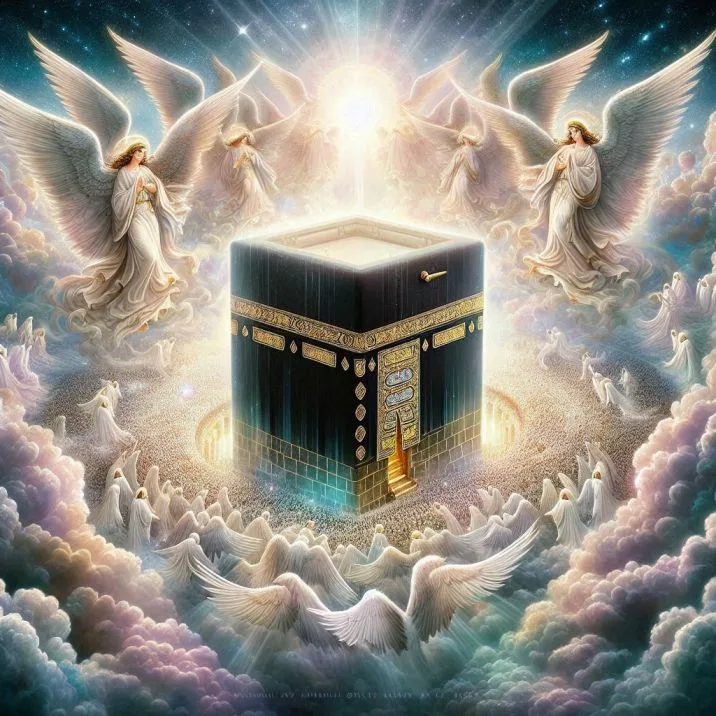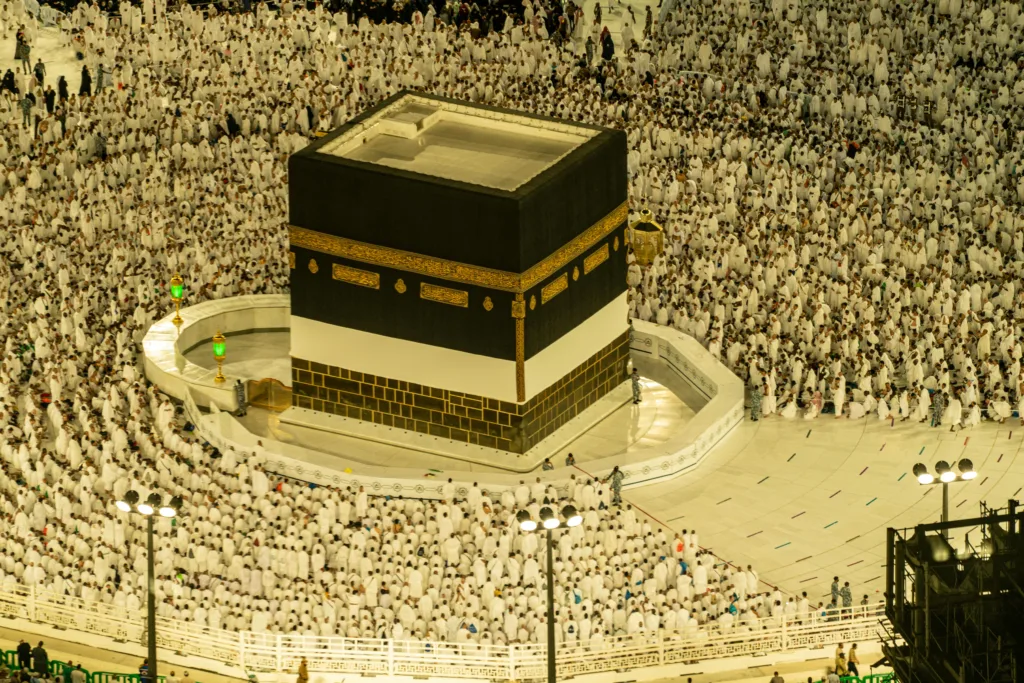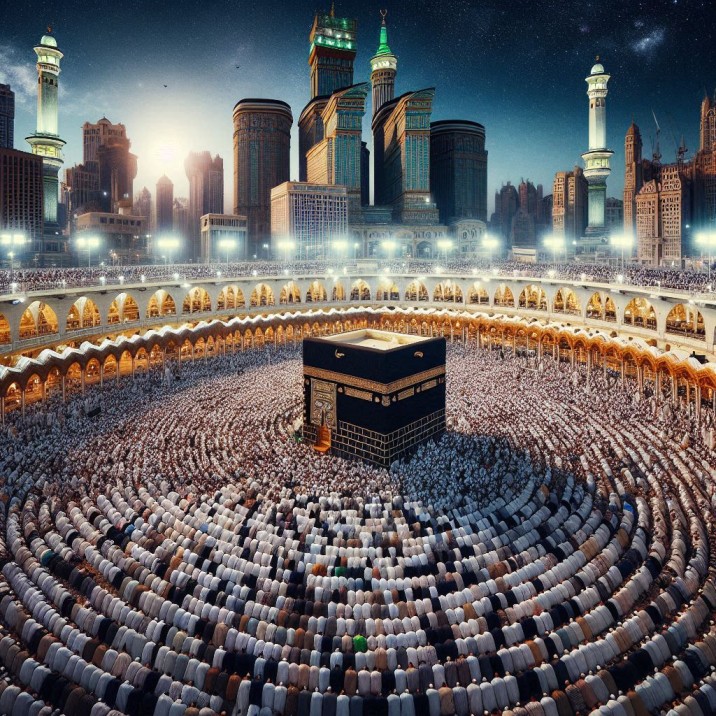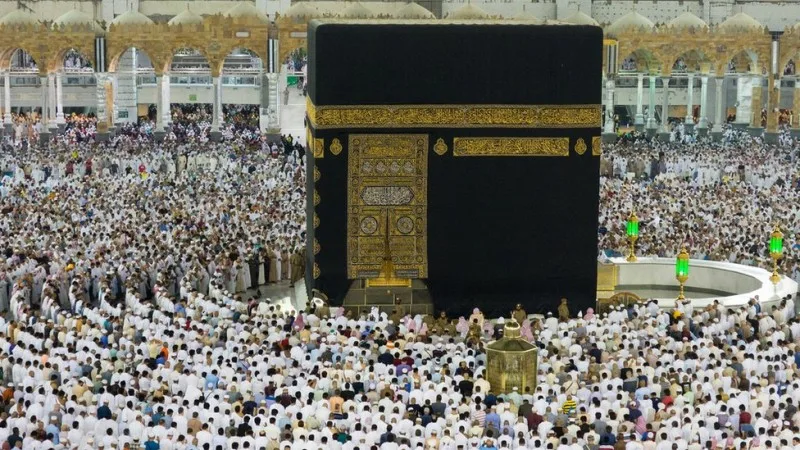The Kaaba, known as the “House of Allah”, stands right in the middle of Al-Masjid al-Haram in Mecca. It is not only the Qibla towards which more than 1.8 billion Muslims stand in prayer daily, but is also a symbol of the unity and sanctity of the Muslim Ummah. For centuries, this sacred structure has been a pillar of the Islamic faith, symbolizing the continuity of submission to Allah (SWT) and the divine messages given by the prophets. However, there are many deep and less-known facts about the Kaaba that increase our respect and appreciation for this blessed structure. Come, let us know about6 Surprising Facts About the Kaaba which will deepen your understanding and connection with this holy site.

Here are 6 Surprising Facts About the Kaaba That Every Muslim Should Know.
Table of Contents
1. The Kaaba is Over 5,000 Years Old, But Its Roots Are Timeless

The house of Allah which we call the Kaaba, Baitullah, or Haram Sharif, was built during the time of Hazrat Ibrahim AS and his son Hazrat Ismail AS, approximately 5000 years ago, as directed by Allah (SWT), they built the Kaaba in monotheism. As the sanctuary was built, people are called to worship one true God. The Qur’an beautifully describes this important event: “And [note] when Abraham was laying the foundation of the house and [with him] Ishmael, [saying], ‘O our Lord, accept it from us. Surely You are the All-Hearing, the Knowing.’ ” (Qur’an 2:127).
But the history of Kaaba goes further than this. According to Islamic tradition, Kaaba was the first house of worship for all mankind, which was built by angels long before the time of Ibrahim AS (Peace be upon Him). Its place was decided by Allah (SWT) as a place where Allah would resort for protection from the devil and actions that cause one to be like him. Prophet Muhammad SA pointed out its importance by saying, “This is truly the house which was established on earth for mankind.” (Sahih Muslim).
The structure of today’s Kaaba has changed in many times, due to its natural and man-made events, but its spiritual essence has never changed. Every stone, every corner and every inch of the Kaaba is the same throughout the centuries and holds devotion, making it a timeless symbol of faith of Islam and submission to Allah (SWT).
2. The is a two Kaaba.

One of the most wonderful and spiritually uplifting facts about that there is 2 kaaba or Baitulla. One is situated in Makkah, Saudi Arab which we as haram Sharif, or Baitulla, or Kaaba and another situated 7th Skies directly above the Kaaba, its call Al-bait-ul-Ma’mur, aligning perfectly in the seven heavens, as decreed by Allah (SWT). Al-Bait Al-Ma’mur is not just a structure; it is a sacred site where 70,000 angels perform acts of worship daily, and once they leave, they never return, replaced by a new group of angels every day.
The Prophet Muhammad SA was given a glimpse of this during the miraculous night journey, Al-Isra wa Al-Miraj. He narrated, “Then I was shown Al-Bait Al-Ma’mur. I asked Jibrael AS about it and he said, ‘This is Al-Bait Al-Ma’mur where 70,000 angels perform prayers daily, and when they leave, they never return to it (but always a fresh batch comes into it daily).’” (Sahih Bukhari).
The existence of Al-Bait Al-Ma’mur shows the deep connection between the heavens and the earth. It reminds believers that their worship at the Kaaba is mirrored by angels in the heavens. This highlights the Kaaba’s central role in the divine order, where worship, unity, and submission to Allah (SWT) go beyond time and space.
3. The Kaaba had 2 Door,
When we go Umrah or Haj, we always see Kaaba has a single door, but it was a 2 door in kaabah.so. Historically, the Kaaba featured two doors, one for entering and one for exit. This architectural designed by Abdullah bin Zubair RA in 64 Hijri, following the advice of Ayesha RA, the beloved wife of the Prophet Muhammad SA.

Ayesha RA narrated, “I asked the Prophet SA about the second door, and he replied, ‘Had it not been for the fact that your people were recently in disbelief (and had left disbelief), I would have had the Kaaba demolished and included the area left out of it (i.e., the Hijr) in its structure, and I would have made its door at a level with the ground and would have made two doors in it, one for people to enter through and the other to exit through.'” (Sahih Bukhari).
So, The Kaaba or Baitulla once had two doors. In 75 Hijri, during a reconstruction led by Hajjaj bin Yusuf, the second door was closed. Since then, the Kaaba has had only one door for both entry and exit.
Also Read :
4. The Kaaba Was Originally D-Shaped,
We everyone know that The Kaaba’s current shape is cubical, and it’s recognized by every Muslims and non-Muslims, but it was not always Cubical. When Prophet Ibrahim AS and Prophet Ismail AS laid the foundations of the Kaaba, it was originally D-shaped. The rounded portion of the Kaaba, known as the Hijr Ismail or the “Hatim,” still remains part of the sacred structure and holds great spiritual significance.

The Prophet Muhammad SA, speaking about the Hijr Ismail, said, “O ‘Aisha, had your people not been still close to the pre-Islamic period of ignorance, I would have dismantled the Kaaba and would have made it on the foundations laid by Ibrahim (AS).” (Sahih Muslim).
The Hijr Ismail is still regarded as part of the Kaaba, and praying within its boundaries is believed to be like praying inside the Kaaba itself. When the Quraysh tribe undertook a reconstruction of the Kaaba before the advent of Islam, they could not afford to rebuild the entire structure and thus left out the rounded portion, giving the Kaaba its current cubical shape.
5. The Black Stone Is Broken, Yet It Remains a Symbol of Unity and Forgiveness

The Black Stone, or Hajar al-Aswad, set in the eastern corner of the Kaaba. Muslims believe that this stone descended from Paradise, and it holds a deep symbolic connection to the origins of humanity and the covenant between Allah (SWT) and His creation. We Muslims believe that if someone kisses the Black Stone (Hajar al-Aswad) then all his sins of his life are forgiven.
The Prophet Muhammad SA emphasized its importance when he said, “The Black Stone came down from Paradise.” (Tirmidhi). However, many are unaware that the Black Stone is actually broken into several pieces. This sacred stone was damaged during the Qarmatian siege of Makkah in the year 930 CE, when it was stolen and taken to Bahrain by the Qarmatians. It was only after 23 years that the Black Stone was returned, but by then, it had been broken into fragments. The Abbasid caliph, upon its recovery, encased the pieces in a silver frame to hold them together.
Even though the Black Stone is broken, it remains a powerful symbol of unity for Muslims worldwide. During Tawaf, pilgrims eagerly try to touch or kiss it, seeking Allah’s forgiveness and blessings. The Prophet Muhammad (PBUH) once said, ‘By Allah! On the Day of Judgment, the Hajar al-Aswad will be given eyes to see and a tongue to speak, and it will bear witness for those who kissed it with sincerity and truth.’ (Tirmidhi).
This prophecy reflects the stone’s enduring spiritual significance and its role in the believer’s journey towards repentance and closeness to Allah (SWT).
6. The Kaaba Wasn’t Always Covered in Black, Reflecting a Rich Tradition of Adornment
Today, the Kaaba is adorned with a stunning black silk and gold-embroidered cloth known as the Kiswah. This tradition, symbolizing deep reverence and honor, was initiated by the Abbasid Caliphate. Before their time, the Kaaba was draped in various colors like green, red, and white, showcasing the rich traditions of the Muslim rulers of those eras.

Even the Prophet Muhammad (SA) participated in this sacred tradition. Historical accounts tell us that during his time, the Kaaba was covered with a cloth made from Yemeni fabric. The Prophet (SA) personally ordered the Kiswah for the Kaaba, which was then draped over the sacred structure. Ibn Kathir, a renowned Islamic historian, mentions in Al-Bidaya wa’l-Nihaya that the Prophet (SA) covered the Kaaba with a Yemeni cloth after his victory in Makkah.
The Kiswah is replacing islamic new year before Hajj, symbolizing the renewal of the Ummah’s covenant with Allah (SWT). This annual event is a moment of great reverence. The old cloth is carefully removed, cut into pieces, and distributed as gifts to dignitaries and pilgrims.
The changing colors of the Kiswah over the centuries reflect the evolving expressions of piety and respect for the Kaaba, highlighting its central role in the spiritual life of the Muslim community. This timeless tradition continues to inspire and unite believers around the world.
Conclusion
The Kaaba is more than just a building; it is the spiritual heart of Islam, representing centuries of faith, devotion, and divine guidance. These astonishing facts about the Kaaba offer a deeper insight into its profound history and its significance in the lives of Muslims. From its ancient origins to its celestial counterpart, from its architectural evolution to the symbolism of the Black Stone, the Kaaba continues to inspire awe and reverence in the hearts of believers.
As we reflect on these facts, we are reminded of the continuous thread of faith that connects us to the Prophets, from Ibrahim AS to Muhammad SA, and to the millions of Muslims who have performed Tawaf around this sacred House. The Kaaba remains a timeless beacon of unity, reminding us of our shared purpose as followers of Islam and our collective journey towards Allah (SWT).
May Allah (SWT) grant us the opportunity to visit the Kaaba, perform Hajj or Umrah, and deepen our connection to this blessed site. May our hearts be filled with the light of faith as we turn towards the Kaaba in our prayers, and may we always be among those who uphold the sanctity and honor of this sacred House. Ameen.
FAQs
1. How old is the Kaaba?
The Kaaba is over 5,000 years old. It was originally built by Prophet Ibrahim AS and his son Ismail AS under divine instruction. The Kaaba has undergone several reconstructions over the centuries, but its spiritual significance has remained unchanged.
2. What is Al-Bait Al-Ma’mur?
Al-Bait Al-Ma’mur is the celestial counterpart of the Kaaba, located directly above it in the heavens. It is a sacred site where 70,000 angels worship daily, and once they leave, they never return, with a new group of angels taking their place each day.
3. Did the Kaaba originally have two doors?
Yes, the Kaaba originally had two doors. This design was introduced by Abdullah bin Zubair RA, based on the advice of Ayesha RA. One door was for entering, and the other was for exiting. However, the second door was later closed by Hajjaj bin Yusuf.
4. What was the original shape of the Kaaba?
The Kaaba was originally D-shaped when built by Prophet Ibrahim AS. The cubical shape we see today is the result of a reconstruction by the Quraysh tribe, who could not afford to rebuild the entire structure and left out the rounded portion.
5. Is the Black Stone (Hajar al-Aswad) broken?
Yes, the Black Stone is broken into several pieces. It was damaged during the Qarmatian siege of Makkah in 930 CE. The Abbasid caliph encased the fragments in a silver frame to hold them together, and it remains a sacred element of the Kaaba.
6. What color was the Kaaba covered in before the black Kiswah?
Before the tradition of covering the Kaaba in black Kiswah began during the Abbasid Caliphate, the Kaaba was adorned with cloths of various colors, including green, red, and white. The color black became the standard during the Abbasid era.
7. Who built the Kaaba?
The Kaaba was built by Prophet Ibrahim AS and his son Ismail AS under the command of Allah (SWT). The foundation of the Kaaba was laid as a sanctuary for monotheistic worship and remains the most sacred site in Islam.
8. Why is the Kaaba important in Islam?
The Kaaba is the qibla, the direction that Muslims face during their prayers. It is the holiest site in Islam, symbolizing the unity of the Muslim Ummah and serving as a focal point for the annual pilgrimage (Hajj) and daily prayers.
9. What is the significance of Hijr Ismail in the Kaaba?
Hijr Ismail is the unbuilt portion of the Kaaba, forming a semi-circular area adjacent to the Kaaba. It is considered part of the original structure built by Prophet Ibrahim AS, and praying within this area is believed to carry great spiritual significance.
10. What happens to the old Kiswah of the Kaaba?
The old Kiswah, the black cloth that covers the Kaaba, is removed and replaced annually during Hajj. The old Kiswah is then cut into pieces and distributed as gifts to dignitaries, pilgrims, and various Islamic institutions around the world.


